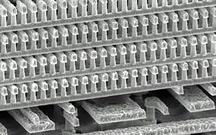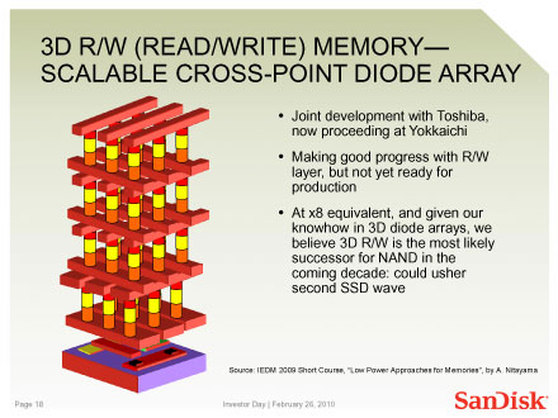
Who did it?
It was Matrix Semiconductor, a Silicon Valley startup, who shipped the world's first monolithic 3D products in 2003. These were One-Time Programmable (OTP) non-volatile memory chips that had multiple layers of polysilicon diodes in series with antifuses. See picture alongside.
Who were the people behind Matrix?
Matrix was founded in 1998 by Mike Farmwald, Mark Johnson, Tom Lee and Vivek Subramanian. Yes, there is indeed a Rambus connection here. Mike Farmwald co-founded Rambus while Tom Lee and Mark Johnson worked at Rambus at some point. Tom Lee and Vivek Subramanian had full-time jobs at Stanford and Berkeley... Mike Farmwald also had to spend time on his other ventures, so the VCs hired a team of execs to run the company. Dennis Segers was hired as the CEO and Siva Sivaram was hired as the COO. These guys put together a great team which executed well to deliver the 3D memory products described above.
Why was this a good idea?
The Matrix team built their monolithic 3D chips with antifuse memory devices and polysilicon diode selectors. There were a few reasons why these guys went for diode selectors instead of transistor selectors.
- Poly diodes could be processed at low thermal budgets, and so one could stack multiple layers of memory above the peripheral logic circuits without damaging them.
- When you stack 4-8 layers of memory, you want to use as few lithography steps as possible for each layer of memory (to keep cost down). A diode needs just one litho step to pattern, while a transistor would need many. So a diode was inherently cheaper to stack.
- It was thought that a 800C processed polysilicon transistor would be hard to scale below 100nm, while a diode being a much simpler device could scale below those dimensions.
What happened to Matrix? Was it successful?
Matrix was bought by SanDisk in 2005 for $238M. A quick search online tells me the VCs invested $80M in Matrix between 1998 and 2001. Nintendo invested $15M in 2001 and there was another $52M round of funding in 2003. I couldn't find out if there was any more money invested in 2004 or 2005. From these numbers, the total investment in Matrix was definitely greater than ~$150M, and it was sold for $238M eight years after it's founding. Hmmm... Matrix was certainly a lot more successful than most start-ups, although I must say the VCs would have liked a better return-on-investment!

SanDisk and Toshiba announced a few years back that they are jointly working on the Matrix technology. The partners said they are trying to replace the antifuse with a rewritable memory element such as phase-change memory or resistive RAM. Please see a slide shown at SanDisk's 2010 analyst day (on the right). Yours truly worked on that project for almost 2 and a half years. What do I think of the technology? Well, that's a story for another day!!! And one that will require several security clearances...
What's the difference between MonolithIC 3D Inc. and Matrix?
In our company, we're trying to stack high quality transistors in multiple device layers. This is a requirement for applying monolithic 3D to market segments such as logic chips, DRAM and NAND flash. It's much harder than stacking polysilicon diodes... but hey, we believe that's the next important milestone for the Monolithic 3D adventure...









 RSS Feed
RSS Feed